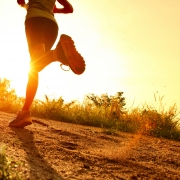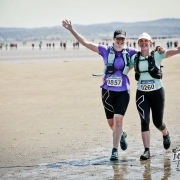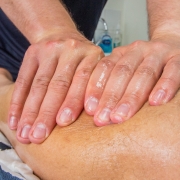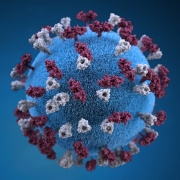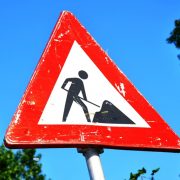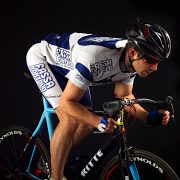Blog – Jenny’s knee injury (7)
/in News, Physiotherapy Advice, Rehabilitation, Running, Strength, Training, Triathlon training/by Pete TangBlog – Jenny’s knee injury
/in News/by Pete TangI don’t like being injured, but then who does!
The worst part for me is how it can feel like your world has changed so quickly. In an instant, you move from taking part in something you enjoy to having not only that moment taken away, but future goals and plans impacted too. At that moment, your whole focus has to change.
Rewind 3 weeks.
I am setting off to complete a hilly, tough 48km trail run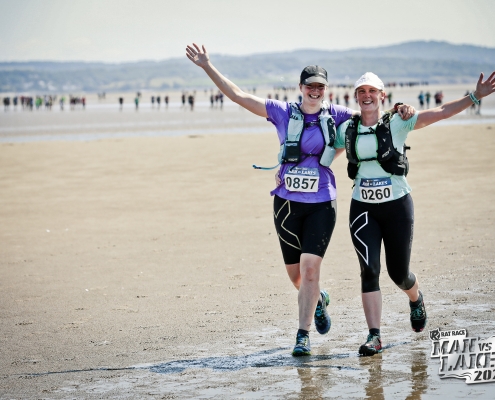 in the Lake District National Park as part of the Rat Race Man vs trilogy of events with my best friend in tow to keep me company. I have already completed the first in the series, Man vs Coast, just 2 weeks earlier coming 21st out of 146 women. So despite the very high temperatures and feeling a little nervous about how well my body had recovered from the previous race, we had excitedly set off. Around 25km in, having already crossed Morecambe Bay and tackled over 2,600 feet of elevation, the pain began to develop on the inside of my left knee. Stubbornly I battled on (there is a medal to be had of course!) but as the next few kilometers ticked by, running reduced to a slow hobble. Even with my friend supporting me on the downhills, it became clear; I was not going to be completing the next 20km. Game over.
in the Lake District National Park as part of the Rat Race Man vs trilogy of events with my best friend in tow to keep me company. I have already completed the first in the series, Man vs Coast, just 2 weeks earlier coming 21st out of 146 women. So despite the very high temperatures and feeling a little nervous about how well my body had recovered from the previous race, we had excitedly set off. Around 25km in, having already crossed Morecambe Bay and tackled over 2,600 feet of elevation, the pain began to develop on the inside of my left knee. Stubbornly I battled on (there is a medal to be had of course!) but as the next few kilometers ticked by, running reduced to a slow hobble. Even with my friend supporting me on the downhills, it became clear; I was not going to be completing the next 20km. Game over.
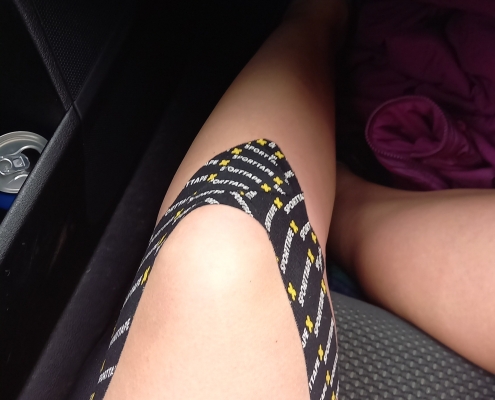 Having made it to a road to be picked up by event support it was time for ice from the medical tent and to apply some kinesiology tape. Inflammation is a natural injury and healing process, so ice is no longer necessarily recommended as the first point of call, however, I needed to get the pain under control and was nervous about taking painkillers while my body was dehydrated and been fuelled by snacks all day. Now was not the time to upset my stomach. My other concern was the next day we were traveling on to Loch Maree in the Scottish Highlands for a week of route recce of the extreme full distance triathlon, Celtman. This was not the plan.
Having made it to a road to be picked up by event support it was time for ice from the medical tent and to apply some kinesiology tape. Inflammation is a natural injury and healing process, so ice is no longer necessarily recommended as the first point of call, however, I needed to get the pain under control and was nervous about taking painkillers while my body was dehydrated and been fuelled by snacks all day. Now was not the time to upset my stomach. My other concern was the next day we were traveling on to Loch Maree in the Scottish Highlands for a week of route recce of the extreme full distance triathlon, Celtman. This was not the plan.
The first-week post-injury – setting priorities
- Monitor for any swelling
- Avoid aggravating factors
- Offload where possible
- Promote healing with gentle, pain-free exercise
- Seated heel sides to maintain range of movement and promote blood flow
- Static quad setting
- General stretches
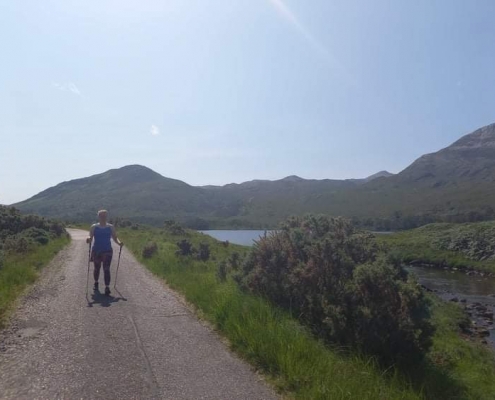 Thankfully I was able to cycle pain-free and went on to tackle the world-famous 2,054ft climb, Bealach-na-ba. Climbing up above the cloud level on the Applecross Peninsula. While running was out of the question, I had bought some trekking poles, so was able to reduce the load through my knee while walking.
Thankfully I was able to cycle pain-free and went on to tackle the world-famous 2,054ft climb, Bealach-na-ba. Climbing up above the cloud level on the Applecross Peninsula. While running was out of the question, I had bought some trekking poles, so was able to reduce the load through my knee while walking.
Questions… Patella tendinopathy? Impinged fat pad? Stress fracture? Would this heal in time for the final stage in the race trilogy, Man vs Mountain in early September?
Sports Massage during Lockdown 2
/in News, Updates/by Pete TangAs of 4th November the Sports Massage Association have published guidance relating to sports and deep tissue massage services provided by their members. Massage services can continue to operate with the following provisions:
That the service operates from a clinical setting.
The service is delivered by a level 4 or 5 therapist or Degree level therapist.
The treatment is clinically justifiable.
Triage and screening of clients occurs prior to any appointment and that PPE and all cleaning and infection control provisions are in place.
I am pleased to report the clinic can meet all these requirements and both Dan and Liz Guest are able to continue to treat patients during this lockdown.
Physiotherapy treatments, including hands on therapy remain open and available to all our clients as we are governed and regulated by the Health and Care Professions Council.
Covid 19 update 31st October 2020
/in News/by Pete Tang31st October update. The clinic will remain open as usual at this time. Medical services and appointments remain unaffected by the latest national lockdown. People with Physiotherapy appointments booked can still attend. We are seeking further clarification on Sports Therapy and Massage services after Thursday 5th November.
We know many of you will have concerns and we understand and will respect people’s choice if they wish to continue with their course of treatment or not at this time.
The clinic has robust infection prevention and control measures in place including strict cleaning between every patient, mandatory wearing of PPE by therapists, temperature checking and Covid screening. Should you have any questions or concerns and wish to discuss anything please get in touch.
May I take this opportunity to thank all our clients for their patience and support during this pandemic. Pete Tang.
Travel Alert June 2019
/in News, Updates/by Pete TangDuring June 2019 the Railway Bridge on Gypsy Patch Lane will be closed to all vehicles in both directions. This is likely to cause travel disruption around the area. Diversion routes will be in place via Aztec West and the A38/Bradley Stoke Way. We have been advised that access to Station Road and the clinic will remain from Gypsy Patch Lane from Bradley Stoke/Winterbourne end. Those traveling from the A38 will need to exit at the Patchway exit slip road from the A38 and travel along Little stoke lane and Clay Lane to arrive at the clinic.
Please allow more time to travel to your appointment during this time and check local travel information.
The Physio Clinic Bristol
Triathlon Coaching – Running Off The Bike
/in Articles, News/by Pete TangAnyone who has ever competed in (or trained for) a triathlon or duathlon knows the horrendous feeling of heaviness in the quads and the jelly legs as you leave the bike rack and enter the run.
Your free-flowing running gait, which was the hallmark of your style when you ran fresh, becomes nothing more than a pathetic and painful shuffle as you struggle to maintain contact with those with whom three minutes earlier you were riding shoulder-to-shoulder.
We have all been there! Take heart: there is hope. By undertaking a couple of practices and incorporating them into your normal training regimen, you can improve your running off the bike.
So what’s happening in your body? Well, it’s a clever machine. Firstly, it will automatically direct blood to where it’s needed. Unfortunately you use different muscles when you ride than when you run. In fact you experience what sports scientists call a vasodilatory effect – or shunting – to the capillaries and the blood vessels which are servicing blood to the muscles. What this means is that blood is not able to get to the running muscles (calves especially) quick enough. As a result, your legs feel heavy and weird as a consequence.
Secondly, your muscles will respond to any demands put on them. In short, an athlete who isn’t practised in the art of transitioning will be slower and less efficient to respond. When you are riding your brain is telling your body to act in a peddling motion for cycling. Quite simply, you do not give your body enough time to respond to the new command when you get off the bike and start to run.
During training, incorporate at least one “brick” session into each week’s schedule. By definition, a brick session means a ride followed immediately with a run. This will force your legs to get used to firing the appropriate neural pathways and shunting blood from previously active to previously inactive muscles a lot quicker, without the pressure of competition.
When considering bricks in your programme, think about the aim of your session. If you’re just trying to get your legs used to running after a heavy bike ride, then this can be done weekly by a short run off a longer bike ride. If you want to maintain or develop race pace through the run, then higher intensity bike/run repeats could be the order of the day. In this case you may wish to use it as one of your high-intensity sessions of the week and provide suitable rest and recovery both before and after the session.
Brick sessions
The following sessions are designed for athletes looking to improve their bike-run performance at their goal race distance…
Sprint triathlete
Target: To deliver a good-paced run from the start.
Duration: 1:15hrs (including a 10min warm-up and 10min cool-down).
Focus: 4 x [5min bike at race pace, 3min race-pace run, 5min easy spin]. Get into your race pace on the run quickly. When running hard off the bike, drive relaxed arms to get legs moving quickly.
Olympic triathlete
Target: To run strongly despite having a tiring body.
Duration: 2:15hrs including 15min warm-up and 10min cool-down.
Focus: 20min run (steady)/30min bike (hard)/15min run (moderate)/30min bike (hard)/10min run (hard).
Middle distance
Target: Develop and improve running off the bike at race pace.
Duration: 2:10hrs including 15min warm-up and 15min cool-down.
Focus: 2 x [30min bike (15mins easy, 15mins race pace), 20min run
(3mins quick feet, 14mins race pace, 3mins just above race pace)].
Long-distance
Target Practise running when tired. Possibly a little out of left field for some but running when tired is an important skill for long-distance races. Adding a swim before the run not only helps the body shift blood from arms to legs but increases the session duration by adding an hour of low-impact exercise.
Duration: 3hrs.
Session: 1hr swim to 2hr run.
Recording Your Mindset
/in Articles, News, Triathlon training/by Pete TangIf you’re like most athletes, I’d guess you’re keen to experience regular improvement in your endurance, speed and enjoyment of training.
So I was wondering…do you keep a training log? 
It’s a widely accepted fact that keeping an ongoing summary of your workouts can shine valuable light on recurring themes and patterns that are either supporting your improvement, or preventing it.
So if you don’t, start now.
(Obviously I use Triblogs to track everything.)
And when you do store the info, what do you include?
The most common areas are distance, time, pace, heart rate and description of the workout.
Smart athletes also record how they felt, for example, things like ‘sluggish’ ‘heavy legs, avoid the curry the night before…’ or ‘really good and light on my feet’.
But those that make the most steady improvements, that overcome ‘plateaus’ and shake bad habits quickly, also track their mindset from each session.
I would encourage you to do the same, starting now.
Here are 3 ways to build awareness of the pattern of your mindset and its impact on your experience.
1. Nature of your thoughts – were they more positive, more neutral or more negative?
Triathlon training is often a time to escape other parts of life and our mind uses this time away to think things through. But if you bring stress, worries, a massive to-do list into the pool or road, that is like wearing ankle weights. Without realizing it your posture, effort and technique is likely to be suboptimal and you end up feeling extra drained at the end of the session.
Even if you do have challenges in your life, you always have the choice to be fully present in your workout and focused on making it a positive session.
2. Direction of your thoughts – was your mind going to distractions or performance cues? What were you focusing on?
It’s ok to let your mind wander somewhat but if you never direct your attention to how you’re executing, do you think you will improve as much as you can?
Stay engaged in your workout, set goals for each workout and have a plan to make it a great one! Obviously sometimes it’s really worth going out to escape life – we all do it. But make sure that the majority of sessions are done with an aim in mind, training toward a particular goal.
3. Number of thoughts – was your mind racing or was it fairly calm? How much mental energy were you expending in that workout?
When you catch yourself rushing in your mind or becoming overloaded with thoughts, gently bring your focus back to the purpose of the session and keep a nice steady breathing rhythm. Avoid the habit of checking your watch every minute and instead use your training to clear your mind, to release tension and enjoy the time you have.
Performance Matrix: Should you be screened?
/in News, Uncategorized/by Pete TangThe Performance Matrix Clinic Poster
We are the only clinic in the South West to offer Performance Matrix Screening & re-training.
The Performance Matrix is the most accurate and powerful screening system available for individuals and athletes wanting to improve movement efficiency, optimise musculoskeletal health, reduce injury risk and enhance performance.
Such is our passion for sport, we don’t want to you to get injured.
Yes, we can help when you are injured but why not take a fresh look & be proactive instead of reactive.
This is the best way to help identify risks & use specialist exercise to prevent injury & increase your own performance
TRX Training Now Available
/in Articles, News/by Pete TangHere is an offer that we will be running from now until the 31st of May 2013.
TRX MASTER CLASS– make sure that you are using the TRX or any other Suspended Training Aid the right way & getting the most out of your session.
This can be done 1-2-1 or 2-2-1 at the same price of only £15.00
What you get:
– A total body work-out program
– The instruction of how to do it properly
To book your session, please call 01454 85 44 66 & book with Matt stating TRX
Get in Contact
We understand that people often don't know what we do or how we can help. Don't worry we're here to help.
To ask us a question or to book an initial appointment simply call 01454 54 00 66 for our Bristol Clinic or 01291 76 99 66 for our Chepstow Clinic and one of our friendly team will assist you with your enquiry.
Alternatively, please fill in the form on the Contact page.
View More TestimonialsTrustindex verifies that the original source of the review is Google. After struggling for a year with debilitating lower back pain, chronic sciatica and being post-partum, Kate Moore (physio) has helped me tremendously. She has built not only my strength back but also my confidence through her detailed, caring and passionate support. She understands the challenges of everyday working/family life and helped me integrate the rehab into that.Trustindex verifies that the original source of the review is Google. I booked in for a running analysis. Pete did a really comprehensive assessment on my recurrent ankle issues and explained things in a lot of detail to help me understand the underlying reasons for my injuries. He gave me the confidence to try running again and equipped me with the knowledge to prevent further injuries. I have seen running specialists / physios / podiatrists in the past but I felt this was the best assessment I’ve had yet. Thanks!Trustindex verifies that the original source of the review is Google. The Physio Clinic was very helpful when I thought I had sciatica. Craig found out what the problem was and gave me advice as well as exercises to do at home. Booking sessions was straightforward.Trustindex verifies that the original source of the review is Google. Saw Pete Tang at the clinic about a knee injury I'd had for a year, which another physio had struggled to properly diagnose or help with. Got a detailed diagnosis on my first visit in June along with an evolving exercise programme and was improving within a month and able to run a half marathon within three. Pete was knowledgeable, friendly and helpful and went through more advanced treatment options if the injury didn't respond – but did not push these and after three sessions told me I was good to go unless things worsened. Highly recommended – thanks!Trustindex verifies that the original source of the review is Google. I was very happy with the treatment I received from Dave and would definitely recommend.Trustindex verifies that the original source of the review is Google. Just had a neck and shoulder sports massage with Luke—highly recommend! He quickly found the problem areas and used the perfect pressure to release tension. I noticed a big difference straight away and felt so much better after. Luke is friendly, professional, and clearly knows his stuff. Would definitely book again!Trustindex verifies that the original source of the review is Google. I had three months of physiotherapy with Dave Mercy starting in June 2025 to help rehabilitate my right foot following a medically necessary operation to break and re-position my heel bone following a diagnosis tibialis posterior tendinopathy with a split tear. The physiotherapy started approx three months after surgery. Dave helped me to progress from being in an air-cast boot on my first visit and unable to put my weight through my foot, onto massages to reduce and eventually eradicate the post surgical swelling in my foot, onto a range of exercises in the gym to exercise, stretch and strengthen my foot and allow me to complete everyday activities that I can now once again enjoy. The support that Dave provided was comforting in the early days and then as the gym exercises progressed, Dave was encouraging and challenged me to develop my foot strength, flexibility, and gave me the confidence to put my full weight through my foot and complete a wide range of exercises that I didn’t think would be possible. I am walking well and whilst the finer aspects of my foot recovery will take longer to achieve, for now I can walk without the pain I previously had, which is a massive achievement. Thanks Dave, you had a hugely positive impact on my level of recovery!Trustindex verifies that the original source of the review is Google. Excellent service, very quick to get me an appointment. Katie did a very good massage on my back and calves - I feel better already :-)Google rating score: 4.9 of 5, based on 282 reviews


